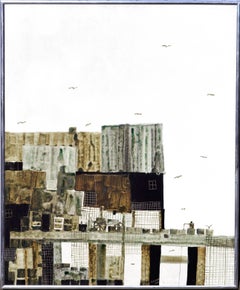Albert Anderson Clymer On Sale
1970s Tonalist Landscape Paintings
Masonite, Acrylic, Stretcher Bars
People Also Browsed
1930s Modern Landscape Paintings
Canvas, Oil
21st Century and Contemporary Abstract Geometric Abstract Paintings
Canvas, Acrylic
1980s Cubist Abstract Prints
Paper, Woodcut
1940s American Realist Figurative Drawings and Watercolors
Paper, Watercolor
1990s Abstract Expressionist Figurative Paintings
Canvas, Mixed Media, Oil
2010s American Impressionist Landscape Paintings
Encaustic
Vintage 1960s American Folk Art Paintings
1920s Modern Landscape Paintings
Canvas, Oil
1980s Contemporary Abstract Prints
Rag Paper, Etching, Aquatint
Artist Comments
Joey Korom manifests an abstract vision of autumn in this dominantly pastel work. He executes the piece with two main colors, light blue, and sand. Prominent ...
21st Century and Contemporary Abstract Abstract Paintings
Acrylic
Mid-20th Century Abstract Landscape Paintings
Masonite, Oil
1940s American Modern Paintings
Canvas, Oil
2010s Contemporary Photography
Archival Pigment
Mid-20th Century Cubist Abstract Paintings
Paper, Gouache
Mid-20th Century Abstract Expressionist Abstract Prints
Lithograph
Late 20th Century Abstract Abstract Paintings
Acrylic, Canvas
Albert Anderson Clymer for sale on 1stDibs
Albert Anderson Clymer, a Denison-reared realist, whose goals were once set on an architectural career, has painted a path to fame since trading his T-square and drafting board for an artist brush and canvas. Intent on pursuing a career in architecture, Clymer began studies at Texas A&M University. After becoming aware of design through architecture courses, he discovered art through architecture, experimenting with painting. It was also through architecture that Clymer was introduced to acrylics, a water-based medium that is quick-drying and easy to clean. He borrowed design concepts along with the acrylic paint from architecture and then added innovative touch-painting on masonite fiberboard to create his style. He was fascinated by the fiberboard because of its ability to draw water quickly, producing different visual effects. Once Clymer realized he liked to paint and could make a living at it, he abandoned architecture in 1967 to become a professional artist. The transition was an easy one because it fit in with his life goals. “I wanted to be self-employed — to have absolute freedom,” said Clymer. “Freedom to stay at home when I wanted to. Freedom to go to Europe when I pleased and freedom to create something that could be cherished.”
Clymer’s dreams became a reality when art critics gave his work favorable reviews. He achieved national recognition through a series of 187 one-man shows and assorted awards in California, Texas, New York and Paris. His paintings are represented in numerous private, corporate and museum collections, and he has been reviewed twice by La Review Moderne Des Arts, Playboy Press and in numerous newspaper articles. Clymer’s artworks have not only drawn rave reviews but have also earned him inclusion in the prestigious Who’s Who in American Art and Men of Achievement.
(Biography provided by Robert Azensky Fine Art)Finding the Right Landscape-paintings for You
It could be argued that cave walls were the canvases for the world’s first landscape paintings, which depict and elevate natural scenery through art, but there is a richer history to consider.
The Netherlands was home to landscapes as a major theme in painting as early as the 1500s, and ink-on-silk paintings in China featured mountains and large bodies of water as far back as the third century. Greeks created vast wall paintings that depicted landscapes and grandiose garden scenes, while in the late 15th century and early 16th century, landscapes were increasingly the subject of watercolor works by the likes of Leonardo da Vinci and Fra Bartolomeo.
The popularity of religious paintings eventually declined altogether, and by the early 19th century, painters of classical landscapes took to painting out-of-doors (plein-air painting). Paintings of natural scenery were increasingly realistic but romanticized too. Into the 20th century, landscapes remained a major theme for many artists, and while the term “landscape painting” may call to mind images of lush, grassy fields and open seascapes, the genre is characterized by more variety, colors and diverse styles than you may think. Painters working in the photorealist style of landscape painting, for example, seek to create works so lifelike that you may confuse their paint for camera pixels. But if you’re shopping for art to outfit an important room, the work needs to be something with a bit of gravitas (and the right frame is important, too).
Adding a landscape painting to your home can introduce peace and serenity within the confines of your own space. (Some may think of it as an aspirational window of sorts rather than a canvas.) Abstract landscape paintings by the likes of Korean painter Seungyoon Choi or Georgia-based artist Katherine Sandoz, on the other hand, bring pops of color and movement into a room. These landscapes refuse to serve as a background. Elsewhere, Adam Straus’s technology-inspired paintings highlight how our extreme involvement with our devices has removed us from the glory of the world around us. Influenced by modern life and steeped in social commentary, Straus’s landscape paintings make us see our surroundings anew.
Whether you’re seeking works by the world’s most notable names or those authored by underground legends, find a vast collection of landscape paintings on 1stDibs.
